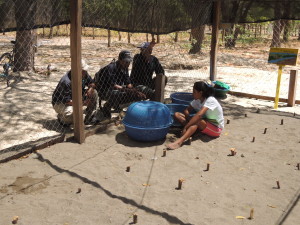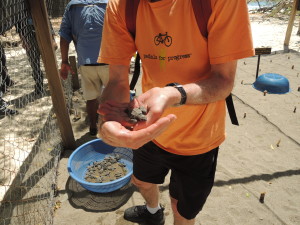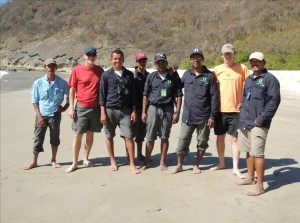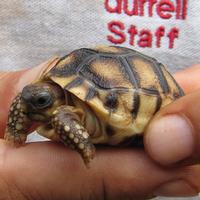by Michael Sabrio
Fall 2014 InGear
The Spring 2014 InGear newsletter introduced the turtle rangers of Paso Pacifico. The rangers patrol beaches in southwestern Nicaragua to try to protect the turtles that nest there. Through a happy collaboration of Paso Pacifico, the Turtle Conservancy, and Pedals for Progress, the rangers now use P4P bikes for commuting and patroling.
In February Gary Michel and I visited the Paso Pacifico rangers and got a first-hand look at what they do. The Paso Pacifico staff in California and Nicaragua were extremely helpful in arranging the logistics. (Thank you, Kate Dolkas!) Paso Pacifico driver Don Meyer Roderíguez picked Gary and me up in Rivas for the 35-mile ride to Ostional Beach, where we would meet the rangers. Claudia Perla, a Paso Pacifico forest ecologist, came along for part of the ride.
Besides their work with turtles, Paso Pacifico has projects on monkeys, reforestation, and “felinos grandes” (big cats) among others. (In 2010, a Paso Pacifico camera trap got photos of a couple of jaguars in areas where jaguars were thought to have been extinct for many years.)
About half our ride was on excellent paved roadway. We passed through the beautiful Pacific Ocean resort town of San Juan del Sur, then headed south on rough unpaved roads. We were there in the dry season, so we had only the bumps, ruts, potholes, and dust to deal with. We wondered how much worse it is in the rainy season and how far the rangers had to travel to get to their patrols. Claudia rode with us to a site near Ostional where she planned to spend a few days with a local family setting up a monitoring program to help determine food resources for spider monkeys. We said goodbye to Claudia and continued down the road to Ostional.
Coco Beach
We stopped at Coco Beach, where Paso Pacifico has one of its turtle hatcheries. A hatchery is a rectangle in the sand near the beach with wire fencing and a covered top to provide shade. Inside, individual plots of a few square feet are marked with the date the eggs were found and estimated date of hatching. Here at Coco Beach, there were no turtle eggs. A sign said that there was lodging and a restaurant here; if you want a vacation truly off the beaten path, this is the place for you.
Refugio del Flor
Our next stop was at Refugio del Flor, a national reserve famous for massive influx of Olive Ridley turtles. Nicaraguan soldiers were posted here when we visited. A board that shows counts of nesting turtles by month and by year has some big numbers – between 23,000 and 30,000 turtles from September through November of last year – but any relief you feel is tempered by very high mortality rates for newborn turtles – at least 90%.
Ostional
 Our final destination was the beach at Ostional. Salvador Sánchez, the Paso Pacifico turtle coordinator (how’s that for a job title), lives right here with his family in a spectacular isolated spot on the beach. We met the rangers on duty that day: Daniel, Eliezer, Erick, Felix, Jairo, Jorlin, Marcos, and Salvador. They had their trusty P4P bikes. Gary and I mounted a couple more P4P bikes that Meyer had picked up from our long-time contacts in Rivas, the Santana family. We left these two extra bikes for the rangers at the end of our ride. Salvador, some of the other rangers, Gary, and I rode our bikes a few hundred yards south to another of the Paso Pacifico turtle hatcheries. Paydirt!
Our final destination was the beach at Ostional. Salvador Sánchez, the Paso Pacifico turtle coordinator (how’s that for a job title), lives right here with his family in a spectacular isolated spot on the beach. We met the rangers on duty that day: Daniel, Eliezer, Erick, Felix, Jairo, Jorlin, Marcos, and Salvador. They had their trusty P4P bikes. Gary and I mounted a couple more P4P bikes that Meyer had picked up from our long-time contacts in Rivas, the Santana family. We left these two extra bikes for the rangers at the end of our ride. Salvador, some of the other rangers, Gary, and I rode our bikes a few hundred yards south to another of the Paso Pacifico turtle hatcheries. Paydirt!
 A batch of a few dozen turtles had just hatched that day. A Paso Pacifico employee was tending them, keeping them safe and healthy. They were to be released that night into the Ocean, which was a few dozen yards from the hatchery. Because of predation by gulls and other shoreline animals, the first few minutes of a turtle’s life – from the time they emerge from the nest, crawl across the beach, and plunge into the ocean – are hugely dangerous. The Paso Pacifico program saves the turtles from at least this threat.
A batch of a few dozen turtles had just hatched that day. A Paso Pacifico employee was tending them, keeping them safe and healthy. They were to be released that night into the Ocean, which was a few dozen yards from the hatchery. Because of predation by gulls and other shoreline animals, the first few minutes of a turtle’s life – from the time they emerge from the nest, crawl across the beach, and plunge into the ocean – are hugely dangerous. The Paso Pacifico program saves the turtles from at least this threat.
We rode our bikes back to the beach at Ostional and took a boat ride to a nearby beach that is a popular turtle nesting site. One of the rangers dug up a nest where the turtles had recently hatched and counted several dozen eggshells plus 4 marble-sized eggs that had not developed. We hoped that the turtles hatched here had made it safely to the Ocean. Because the turtles come ashore at night, the rangers’ schedule must accommodate them. A couple of the guys on our ride were getting ready to start their 6pm to 6am shift. They explained that their jobs are sometimes routine and sometimes dangerous. Sometimes there is nothing to report. Rangers have no official authority to confront or stop poachers, who may be armed. The rangers rely mostly on their ties to and respect from the community. It also helps that Paso Pacifico pays compensation to local people who help with its conservation programs. People who find a turtle nest get money when they bring the eggs to a Paso Pacifico hatchery. Families who lose livestock to predation by the big cats and even people who can show evidence of the cats (such as cell-phone photos) are also paid.
Besides being incredibly interesting and beautiful, our trip gave us a better appreciation of how much a bicycle can help people do their jobs where transportation is unreliable and expensive. We also have a better appreciation of how hard it is to balance the preservation of ecosystems and rare animals with the day-to-day survival of very poor people.



![Rangers and bicycles for Christmas[3]](https://www.p4p.org/wp-content/uploads/2014/01/Rangers-and-bicycles-for-Christmas3-300x197.jpg)